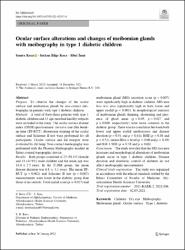| dc.contributor.author | Koca, Semra | |
| dc.contributor.author | Koca, Serkan Bilge | |
| dc.contributor.author | İnan, Sibel | |
| dc.date.accessioned | 2022-05-12T13:54:39Z | |
| dc.date.available | 2022-05-12T13:54:39Z | |
| dc.date.issued | 28.01.2022 | en_US |
| dc.identifier.citation | Koca, S., Koca, S. B., & İnan, S. (2022). Ocular surface alterations and changes of meibomian glands with meibography in type 1 diabetic children. International Ophthalmology, 1-9. | en_US |
| dc.identifier.issn | 0165-5701 | |
| dc.identifier.issn | 1573-2630 | |
| dc.identifier.uri | https://doi.org/10.1007/s10792-021-02155-8 | |
| dc.identifier.uri | https://hdl.handle.net/20.500.12933/993 | |
| dc.description.abstract | Purpose: To observe the changes of the ocular surface and meibomian glands by non-contact meibography in patients with type 1 diabetic children.
Methods: A total of forty-three patients with type 1 diabetic children and 43 age-matched healthy subjects were included in the study. The ocular surface disease index (OSDI) questionnaire, invasive tear film break-up time (TF-BUT), fluorescein staining of the ocular surface and Schirmer II test were performed for all participants. Ocular surface and lid margins were evaluated by slit lamp. Non-contact meibography was performed with the Phoenix-Meibography module in Sirius corneal topographic device.
Results: Both groups consisted of 25 (58.1%) female and 18 (41.9%) male children and the mean age was 14.4 ± 2.5 years. In the T1DM group, the mean disease duration was 6.8 ± 3.1 years. The mean TF-BUT (p = 0.002) and Schirmer II test (p = 0.007) measurements were lower in the diabetic group than those of in controls. Total eyelid score (p = 0.027) and meibomian gland (MG) secretion score (p = 0.007) were significantly high in diabetic children. MG area loss was also significantly high in both lower and upper eyelid (p < 0.001). In morphological analyses of meibomian glands thinning, shortening and presence of ghost areas (p = 0.05, p = 0.027 and p = 0.000, respectively) were more common in the diabetic group. There was no correlation between both lower and upper eyelid meiboscores and disease duration (p = 0.51 and p = 0.61), BMI (p = 0.08 and p = 0.51), serum HbA1c level (p = 0.06 and p = 0.49) and IGF-1 SDS (p = 0.38 and p = 0.68).
Conclusion: The study revealed that the MG loss area increases and morphological alterations of meibomian glands occur in type 1 diabetic children. Disease duration and metabolic control of diabetes do not affect meibography measurements. | en_US |
| dc.language.iso | eng | en_US |
| dc.publisher | Springer | en_US |
| dc.relation.isversionof | 10.1007/s10792-021-02155-8 | en_US |
| dc.rights | info:eu-repo/semantics/embargoedAccess | en_US |
| dc.subject | Children | en_US |
| dc.subject | Dry eye | en_US |
| dc.subject | Meibography | en_US |
| dc.subject | Meibomian gland | en_US |
| dc.subject | Ocular surface | en_US |
| dc.subject | Type 1 diabetes | en_US |
| dc.title | Ocular surface alterations and changes of meibomian glands with meibography in type 1 diabetic children | en_US |
| dc.type | article | en_US |
| dc.authorid | 0000-0002-8275-1507 | en_US |
| dc.authorid | 0000-0002-9724-2369 | en_US |
| dc.authorid | 0000-0001-8332-2205 | en_US |
| dc.department | AFSÜ, Tıp Fakültesi, Cerrahi Tıp Bilimleri Bölümü, Göz Hastalıkları Ana Bilim Dalı | en_US |
| dc.contributor.institutionauthor | Koca, Semra | |
| dc.contributor.institutionauthor | Koca, Serkan Bilge | |
| dc.contributor.institutionauthor | İnan, Sibel | |
| dc.identifier.startpage | 1 | en_US |
| dc.identifier.endpage | 9 | en_US |
| dc.relation.journal | International Ophthalmology | en_US |
| dc.relation.publicationcategory | Makale - Uluslararası Hakemli Dergi - Kurum Öğretim Elemanı | en_US |
















